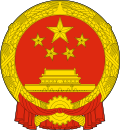Autonomous District (China)
Autonomous districts ( Chinese 自治州 , Pinyin zìzhìzhōu ) are administrative units in the People's Republic of China below the provincial level. There are currently 30 autonomous districts in China (as of December 31, 2012). This number has been stable for many years.
After the five autonomous regions (provincial level), the autonomous districts are the second highest administrative unit in China with regional ethnic autonomy. It is required by law that the district head must be of the nationality exercising the autonomy rights. Autonomous districts are composed of independent cities, districts and autonomous districts at the district level.
District level administrative systems
In the administration of China there is the district level ( 地 级 ) below the provincial level . At this level, a distinction is made between district-free cities ( 地 级 市 ), administrative districts ( 地区 ), Bünde ( 盟 ) and autonomous districts.
Autonomous districts and prefecture-level cities are administrative divisions of the first degree, i. i.e., they have - such as B. the superior provinces and the subordinate districts - via both chambers of parliament ( People's Congress and Consultative Conference ), as well as via a people's government ( 人民政府 ), which is elected by the People's Congress of the city or the autonomous district. Administrative districts and federations, on the other hand, are administrative divisions of the second degree, namely "provincial central authorities", i.e. That is, they have no people's congresses, no consultative conferences and, above all, no people's governments. Instead, they have an administrative office ( 行政公署 ) as government. The administrative office is set up by the superordinate provincial or regional government. Autonomous districts and district-free cities thus occupy a slightly higher rank than administrative districts and confederations. This is expressed e.g. B. in the fact that in Xinjiang two administrative districts ( Tacheng and Altay ) are subordinate to an autonomous district ( Ili ). In this special case, the government of the autonomous district appoints the administrative offices of the two administrative districts.
List of all of China's autonomous counties
See: Autonomous Administrative Units of China
See also
literature
- Sebastian Heilmann : Political System, 3rd People's Republic. In: Stefan Friedrich, Hans-Wilm Schütte, Brunhild Staiger (eds.) The great China Lexicon. History, geography, society, politics, economy, education, science, culture. Wissenschaftliche Buchgesellschaft, Darmstadt 2003, ISBN 3-534-14988-2 , pp. 575-578.
- Erling von Mende , Heike Holbig: Local administration. In: Stefan Friedrich, Hans-Wilm Schütte, Brunhild Staiger (eds.) The great China Lexicon. History, geography, society, politics, economy, education, science, culture. Wissenschaftliche Buchgesellschaft, Darmstadt 2003, ISBN 3-534-14988-2 , pp. 456–458.
- Meyer's Atlas China. On the way to world power. Bibliographisches Institut AG, Mannheim 2010, ISBN 978-3-411-08281-0 , pp. 92-93.
- Yin Zhongqing (尹中卿): The political system in China today. China Intercontinental Press, Beijing 2004, ISBN 7-5085-0470-4 .
